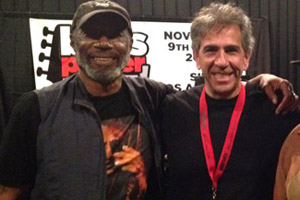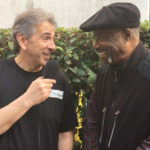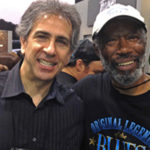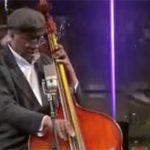Bass legend talks of working with Aretha Franklin, King Curtis, B.B. King and Wilson Pickett
Exclusive interview with FBPO’s Jon Liebman
July 6, 2009
As a child, when Jerry Jemmott first heard Paul Chambers play the bass, he made up his mind, practically on the spot, that he wanted to become a bass player. Though jazz was among his earliest musical influences, Jerry later discovered the allure of funk and R&B. Little did he know what a profound impact that discovery would have on his life and career.
A seminal session bassist in the’60s and ’70s, Jerry became one of the architects of the Atlanta Records/Muscle Shoals sound, as the world was introduced to soul music. During this historic time, Jerry was right in the thick of things, laying down those unforgettable bass lines for Aretha Franklin, King Curtis, B.B. King, Wilson Pickett, Roberta Flack, The Rascals and countless others. He is considered by many to be one of the most influential bass players of our time.
FBPO: Tell me about growing up in a musical family and how Paul Chambers really tripped your trigger to become a professional bass player.
JJ: Although music was always around me, I took it for granted as a member of a family that sang and played various instruments, including the bass. I never saw myself participating as a musician until I heard Paul Chambers. The man was magical in his rhythmic and harmonic interpretation of music. I never copied his lines, but in general, it was just that his way was the way that I thought things should be done, without really having to think about it. Finally, there was something for me to do that I could put my heart and soul into! During this time, I was 11 years old and I didn’t give any thought to becoming a professional musician; it just happened when I joined Smilin’ Henry & the Rhythm Makers at the age of 12.
Having Paul and later (Charles) Mingus in my head gave me a guide to create and develop a groove. As time went by, I would also discover more great bass players, including Sam Jones, Percy Heath, Arvell Shaw, Ray Brown, Eddie Jones, Leroy Vinegar, Doug Watkins, Edgar Willis, Aaron Bell, and many others,whose solid grooves inspired me. Most especially, when I think of laying down a solid groove, Thelonious Monk’s bassists Ahmed Abdul-Malik, John Ore and Wilbur Ware always come to mind. They were true masters of the art.
In 1960 the “light bulb” came on after seeing the affect my playing had on the audience while playing a jazz concert. Later that year, as a member of Alfie Wade’s Big Band, I found out that many of the heroes I’d heard so many times in my own record collection – George Duvivier, Milt Hinton, Richard Davis… and the big bands of Basie, Ellington and Ferguson – were doing “studio” work in the “Jazz Capitol of the World.” That’s when I set my sights on that career.
FBPO: How did you make the transition to electric bass?
JJ: It took a while, but I started moving towards more soulful and rhythmic playing. I was deeply influenced by the music of Horace Silver and other “Soul Jazz” legends, plus the experience of playing with “Pucho & the Latin Soul Brothers.” It was 1964 when I made the switch to electric. I was playing in various rhythm & blues bands, most notably with guitarist and singer, Lester Young & the California Playboys, where I met New Orleans drummers Charles “Honey Boy” Otis and Leo Morris, who later became Idris Muhammad. I was playing in some other bands, too, with drummers Reggie Ferguson, Reggie Barnes, and George Bragg. All of those experiences enabled me to develop my style.
After hearing some of the stuff coming out of the radio, I felt that there was a lack of “funk” coming from the bass chair, which led me to believe that I needed to “show them what to play!” [Laughs]. That mission, however, turned out to be easier said than done. It became more of a subliminal thing and when the opportunity came, I forgot about showing anybody anything and thought only about the thrill of walking into the studio and playing with a group of musicians – sometimes strangers – and doing my part to “lead” these geniuses down the road to make a hit. Our goal was to record four songs in three or four hours, and go through that whole process three times a day. We strived to make new music and bring joy to people’s souls while telling stories that needed to be told – and get paid! It was a magical time for music during the height of the Civil Rights struggle in the mid-’60s. The music we produced became a soundtrack for folks to rally around.
FBPO: How did your early influences enable you to become such an in-demand studio bass player?
JJ: Growing up, my entry into the world of the arts came as a tap dancer with Mary Bruce’s “Star Buds” when I was 5 years old. We had our annual review at Carnegie Hall. I was immersed in music and dance, but in those days the bass was not as audible and my ear and knowledge weren’t good enough to copy the notes that went by so fast and changed so frequently. I could remember the rhythm, though, so I got into the habit of making up my own lines. I used to listen to all styles of music, but it was jazz that got me started. In the end, the flexibility it required enabled me to do studio work with or without written music, which was the lure that initially fueled my fire.
Ironically, as time went by, I ended up working with many of my heroes on a daily basis in different situations, whenever they were available. Folks like Seldon Powell, Joe Newman, Billy Butler, Cozy Cole, Thad Jones, Mel Lewis, Herbie Hancock, Keith Jarrett, Specs Powell, Montego Joe, Johnny Pacheco, Benny Powell, Ray Barretto, Rudy Stevenson, Snookie Young, Joe Farrell, Grady Tate, David “Fathead” Newman, Paul “Hucklebuck” Williams, Hubert Laws, Clark Terry, Freddie Hubbard and so many others. What an honor and a thrill just to be in the same room with them!
These musicians not only welcomed me, but inspired and encouraged me while I refined and developed my own style and the role of the bass. As time went on, I started to get recognition from J.J. Jackson and King Curtis, then eventually Jerry Wexler, Horace Ott, Bert Decateaux, Arif Mardin, Bill Symzyck, Jerry Ragovoy, Tom Dowd, Gene Paul, Tony May, Don Sebesky, Jimmy Douglas and a host of other great producers, arrangers, engineers and musicians who just let me “do my thing” while participating in their projects.
FBPO: It must have been quite an experience recording with all those great players.
JJ:Was it ever! On any given day, the rhythm sections in those studios included Eric Gale, Bob James, Bernard Purdie, Cornell Dupree, Vincent Bell, Gary Chester, Hugh McCracken, Dick Hyman, Stuart Scharf, Bob Dorough, Jay Berliner, and a host of talented singers that would come together to make history.
FBPO: In all those years of performing and recording alongside countless musical luminaries and legends, you must have some great stories to tell. Can you share one or two?
The publishing houses were full of tracks that were often sold. Some of them became big hits, too. The most notable example was “Dancing in The Streets,” by Martha & the Vandellas, where you can hear both Herb Lovelle and Bernard “Pretty” Purdie on the drums. There was also the track sharing connection between, Jerry Ragovoy, Jerry Wexler and Rick Hall, which led to the development of the “Muscle Shoals Sound,” in which Duane Allman and I would become key players. All of the artists that we worked with were always on their best behavior under the microscope of the studio environment, but we guys in the band always found ways to help loosen things up and have fun during the most serious of sessions. I’ll never forget the sight of watching some of the cats in the string section simultaneously read the New York Times while playing their parts, or Paul Griffin making up his own set of lyrics to the track that we were laying down that had no melody. This “tracking” became business as usual with the perfection of multi-tracking, pioneered by jazz guitarist Les Paul.
With this constant source of creative musicians in New York, most of the major labels had studios or offices there. It was at Columbia Records’ 30th street studios where I first met Aretha Franklin via a life-sized portrait of her sitting on a piano bench on the wall of the control room. I used to drool over it between playbacks! Paul Griffin and Herb Lovelle, my favorite section-mates, told Jerry Wexler about her and when her contract at Columbia was up, she signed with Atlantic. When I got the opportunity to record with her, starting with “Think” in 1968, I morphed into “Dr. Feelgood” and she tried to hire me on the spot! [Laughs]
FBPO: The world is still in shock after the recent untimely death of Michael Jackson. What impact did he have on your career?
JJ: First of all, my sincere prayers go out to him and his family. His passing brings back to mind the sense of competition during those times in the great hubs of music creation, namely Chicago, Nashville, Los Angeles, Philadelphia, and especially Motown. That competition intensified with the string of hits the Jackson 5 and others were putting out, especially with the bass work that was done or inspired by the great James Jamerson, which pushed us New York cats to be even more creative and take more chances.
Having been on stage myself at a young age, I’ve always had a kinship with Michael, who was, like me, born in the Year of The Dog. This real-life Superman knew that “the fun is in the getting there” and he never gave up his pursuit for perfection. He was forever faithful to his cause and always stopped to smell the roses, as he lived his life to give people what they needed. To me, he represents a beacon of hope and possibilities through his many gifts and achievements, all in the name of love. His body of work will forever live in all of us. How is it possible to see the words “Beat It” or “I’ll Be There” and not hear and see him? Ride on Michael, with your bad self!
FBPO: I bet a lot of people don’t know that, in addition to being “The Groovemaster” bass player, you’ve arranged and conducted music for films, Broadway musicals and Off-Broadway shows. How did that come about?
JJ: The advent of the drum machine and synthesizer marked the beginning of the end of studio work for me and a lot of other folks. Also, after a near fatal auto accident in 1972, I turned to composing, arranging, conducting and touring to maintain my sanity, as I adjusted to the limitations caused by my injuries and the need to keep a roof over my head.
FBPO: Wasn’t it around that time that you started practicing Buddhism?
JJ: It was during the following year, actually, that Richard Davis, introduced me to the chanting of Nam Myoho Renge Kyo and I began practicing True Buddhism, sometimes referred to as Nichiren Shoshu Buddhism. It explains life to be a series of causes and effects that encompass the past, present and future, resulting in what is commonly known as karma. It also offers tools to eradicate the negative and enhance the positive, while attaining wisdom and the opportunity to express one’s gratitude. That being said, it became my “Ship To Cross the Sea of Suffering.” All of my work comes from this approach to living a balanced life in order to reach one’s full potential.
From this practice of True Buddhism, I gleaned what I call it the Logic of “Multi-Ality” – the wisdom to have more than one way of recognizing, memorizing and reproducing any reality. With assiduous and consistent effort, a person’s boundaries become a springboard for greater accomplishments with less stress. You had better believe that I have to use all of this while participating in and conducting clinics and workshops, in addition to touring with living legend and Southern soul/rock icon Gregg Allman. My choice of instruments reflects this Logic of “Multi-Ality” and a “less mess, less stress, more success” strategy.
FBPO: Tell me about basses.
JJ: My favorite bass for the gig is Mona, the ’64 Fender J bass that I’ve used on most my recordings. For my backup I have Nichiko, a ’62 J bass. Depending on the venue, they may switch roles. Shafafa, the bass with the scroll headstock that I designed with Abe Rivera in ’83, and Miss Green, the ESP Horizon that I designed in ’81, both stay home. I use the same strings on all of them, Ken Smith Medium Slick Rounds. I find that great straps make a big difference so I use Double Treble and Mono straps.
FBPO: Not only are you an accomplished player and writer, but you are also an educator. What prompted you to want to share your knowledge and experience with others?
JJ: It has been said that “no education is complete without the arts, which express our innate creativity; music is the envy of all the arts.” When I started playing, all I could do was read music. I had a hard time hearing the tones and was never taught to understand the theory. I gained my knowledge and honed my craft through trial and error while under the pressure of live performances.
Once I began teaching in 1976, I formally sat down with the books and eventually gained some invaluable insight from one of my most famous disciples, Jaco Pastorius, while we hung out in preparation for his video. It dawned on me that the most valuable tool I could offer to combat the pain of ignorance was the ability to be able to learn, so I came up with a verbal system to learn musicianship whereby the students actually teach themselves. This learning system, “Say It, Sing It, and Play It!” is in my eBook, There’s Music In Everyone! It was originally titled The Bass In You and was published last year by my company, C Souler Energy Publications. In addition I get my learning system out to the world market via my Personal Expression Through Musicianship Clinics, Workshops, Distance Learning and other publications.
Over the years of practicing True Buddhism I came to realize that when we study without the context of an overall system, it becomes difficult to understand the significance of the components and elements that are involved. Based upon the actualization and retention of usable knowledge, my intuitive verbal learning system involves the Total Person through cross-referencing, which becomes a systematic process of Revelation, Explanation and Demonstration. There’s a lot less stress when you know what you’re doing, even if it is just wiggling your fingers! Make the cause, get the effect. Nam Myoho Renge Kyo!




